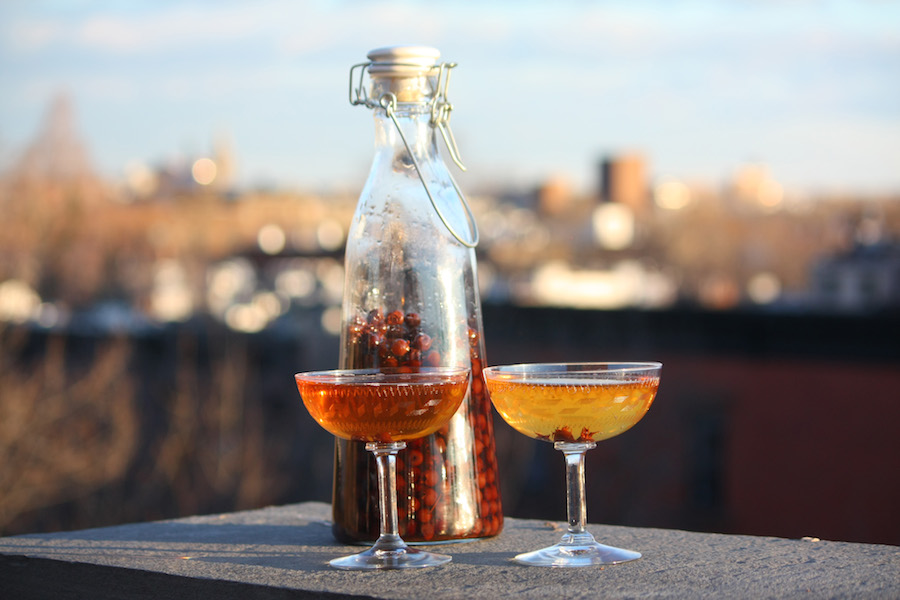Every June I walk down to the noisiest park in the world, between the Manhattan and Brooklyn bridges, where traffic roars overhead and conversation must take place in the lull between racketing trains passing like partying steel bands high across the East River. This year my friend Ellen Zachos will meet me there on the grassy mound, with a bottle of her Amelanchier wine, made from berries we foraged on this spot last year. We will picnic, and then, with liquid fire in our bellies, we will head into the bushes. Because we need more.
Native to every state, barring Hawaii, the Amelanchier genus is a collection of tough trees and shrubs capable of surviving brutal winters and blooming in early spring to coincide with the running of the shad, earning them one of their many common names: “shadblow.” They are also called “serviceberries,” their white flowers opening around the time when the ground thaws sufficiently for caskets to be lowered into it for the first spring burials. Here in Brooklyn the berries ripen in late May and remain red and then purple through June, giving them another common name: “juneberries.”
Brooklyn is particularly rich in what has fast become one of my favorite plants. The little park on the water in DUMBO has half a dozen trees as well as shrubs of a different species, for variety, and the new Pier One section of the Brooklyn Bridge Park downstream has been planted with mature Amelanchier specimens. How considerate of the planners.
Another unlikely spot for the fresh fruit is the wind-battered pedestrian mall linking Jay Street with the Brooklyn Bridge Boulevard (Adams Street), near the Jay Street-Borough Hall subway stop. The trees in raised beds are white with blossoms each April and literally bent with ignored abundance come June. Amelanchier on neighborhood sidewalks are my personal reference points for when the fruit begins to redden. That’s when I call Ellen to save a picnic date.
When picking the berries I eat them fresh, out of hand. The flavor is frankly sweet, without the tart edge of blueberries, and the tiny seeds when crunched release a frisson of cyanide. This almondy essence becomes deeply pronounced when the fruit is cooked: Amelanchier pie is redolent of marzipan. Amelanchier jelly is better than the jam—the clear scarlet juice free of the small seeds is a wobbly perfection on white morning rolls. I mix Calvados and juneberries and macerate the fruit for six months, unstoppering the bottle when early summer seems a preposterous memory. Splashing some dry sparkling wine onto a measureful creates a drink that seamlessly melts continents into a buzz in the mouth. I call it a “Transatlantic.” Disks of crisp, buttery shortcrust pastry topped with a warm compote of juneberries (just add sugar and a little lemon juice), beneath a dollop of pillowy whipped cream are what I may whimper for when The End threatens.
Early summer is a happy time for berry connoisseurs in the city. Ripening at the same time as juneberries, mulberries are often despised as a coagulating purple mess underfoot on June sidewalks. But they are wonderful to eat, unappreciated as one of the most elusive and fleeting tastes in the berry world. Too delicate to withstand transportation, the fruit, each resembling a miniaturized bunch of grapes, are seldom seen even at farmers markets. A massive tree in the Brooklyn Botanic Garden provides me with covert handfuls and the penetrating flavor of the black juice rushes me back in time to Bloemfontein, South Africa, where I feasted on ripe mulberries as a little girl. Perched in the branches of Mrs. Du Toit’s tree in her Paul Roux Street garden I filled a Pyrex bowl with the purple orbs before bringing them home next door, to be eaten with cream for dessert.
Firm juneberries are easy to collect by the bucket, stripped from their branches, but mulberries squash, bruise and bleed. I drop them softly into small brown paper lunch bags, my red-inked hands giving my predilection for wild fruit away on the subway. Tucked into tiny tarts with a handful of juneberries or raspberries, the mulberries ooze their amethyst syrup through the warm pastry. They’re gone in a matter of bites but extend their season in the ever-after retelling of their warm succulence. Who says you can never go home again?
Ripe for the picking. Mulberries and Amelanchier can be eaten out of hand, tucked into tarts or steeped in Calvados for six months, to drink when summer seems a preposterous memory.
Photo credit: Marie Viljoen.



